Units of measurement: Free printable worksheets for 3rd graders
Are you looking for a fun and easy way to teach your kids about units of measurement? Do you want to help them master measuring length, mass, volume, and temperature? If so, you've come to the right place!
-
Most kids and even adults find units of measurement complex to understand. So, instead of teaching them this concept with some boring activities, try our fun and free printable units of measurement worksheets for your 3rd graders. You will love and enjoy all the teaching methods we will provide for you.
In this article, we’ll share some tips and tricks on introducing units of measurement to your 3rd graders, how to use online resources to enhance their learning, and how to easily access free printable worksheets for 3rd graders.
We’ll also introduce you to our website, Mathskills4kids.com, where you can grasp fun worksheets covering all units of measurement topics. In addition, we will give you some ideas for fun activities and games you can do with your kids to reinforce their measurement skills. And finally, we'll show you how to assess their progress and mastery of units of measurement.
Ready to get started? Let's go!
Why units of measurement matter for 3rd graders: A fun introduction
Hello teachers and parents, let’s begin our units of measurement discussions with a fun introduction and tips on why units of measurement matter for 3rd graders.
Units of measurement are important for many reasons. They help us describe the world around us, compare different objects and quantities, and solve problems involving measurements. They also help us communicate with others who use the same or different units of measurement.
For 3rd graders, learning about units of measurement is a key part of their math curriculum. It helps them develop their number sense, spatial reasoning, and problem-solving skills. It also prepares them for more advanced topics in math and science, such as fractions, decimals, geometry, and physics.
-
BROWSE THE WEBSITE
-
DOWNLOAD FREE WORKSHEETS
-
-
3rd GRADE MATH TOPICS
- Number and compapring
- Place value
- Addition
- Subtraction
- Understand multiplication
- Multiplication skill builders
- Multiplication fluency
- Multiplication
- Understand division
- Division skill builders
- Division fluency
- Division practice
- Mixed operation
- Properties
- Equations & variations
- Estimate & rounding
- Logical reasoning
- Patterns
- Money
- Telling time
- Data graph & probability
- Understanding fractions
- Equivalent fractions
- Comparing and ordering fractions
- Operations with fractions
- Unit of measurement
- Two-dimensional shapes
- Triangles and quadrilaterals
- 3D shapes
- Geometric measurement
-
-
How to read a thermometer
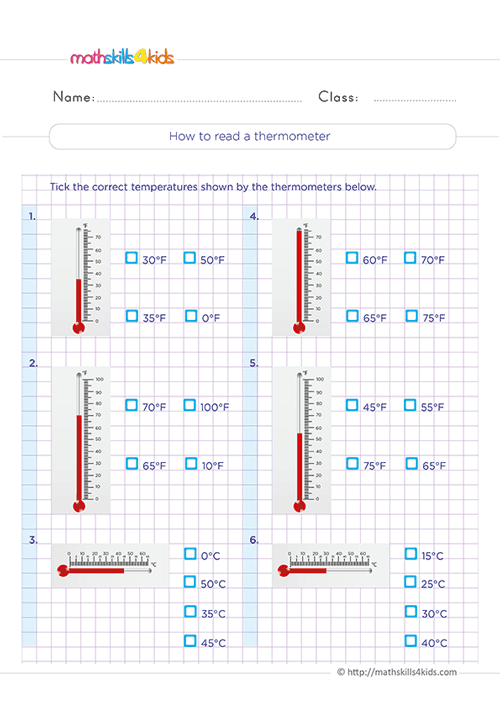 Print it...
Print it...
-
How to measure using an inch ruler
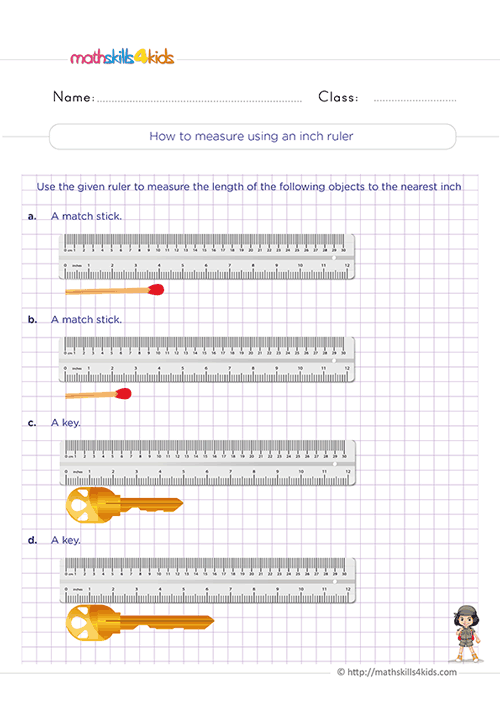 Print it...
Print it...
-
Which customary unit of weight is appropriate?
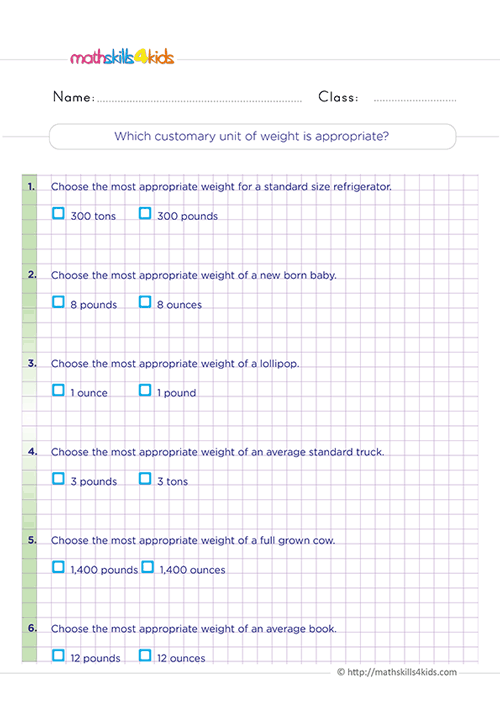 Print it...
Print it...
-
Which customary unit of volume is appropriate?
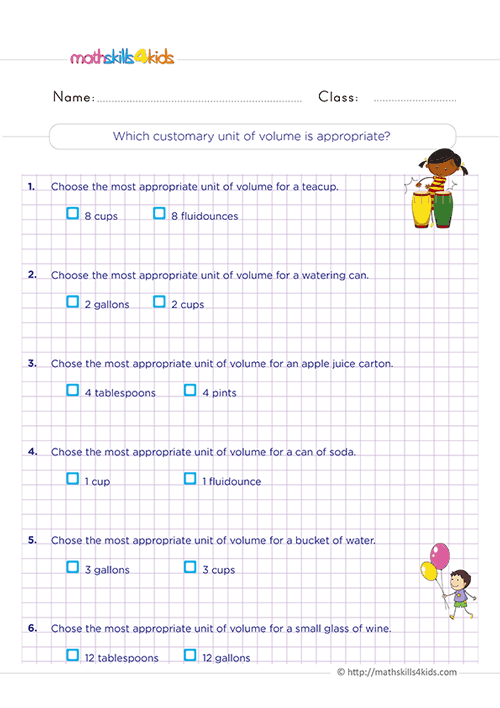 Print it...
Print it...
-
Which metric unit of-length is appropriate?
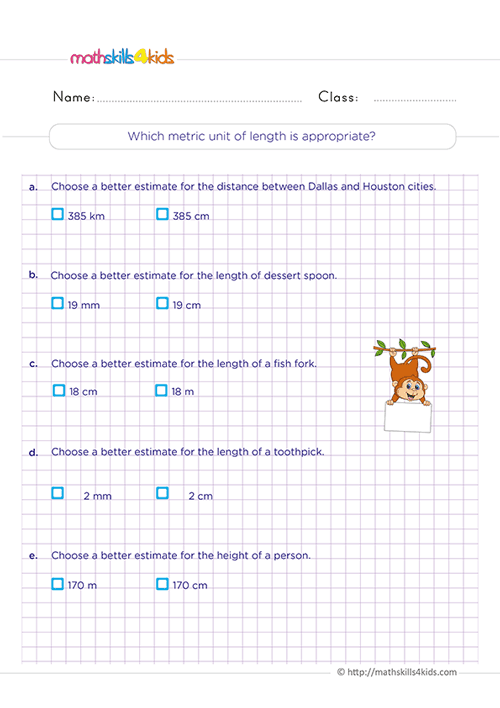 Print it...
Print it...
-
Choosing the correct measuring tool practice
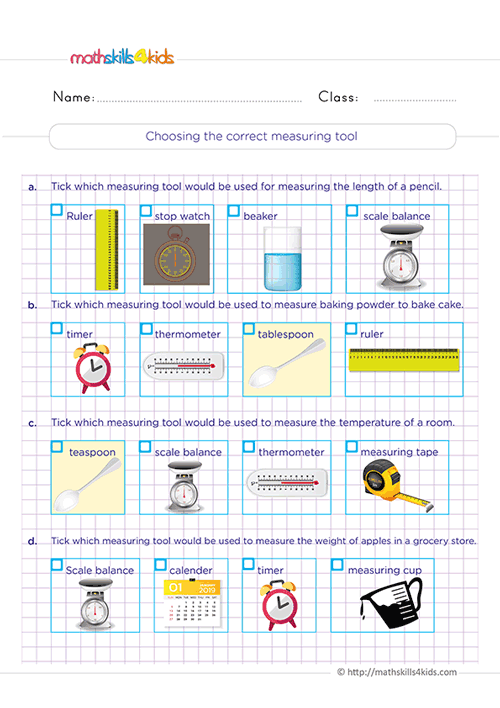 Print it...
Print it...
-
How to read a thermometer
-
Buying is supporting us!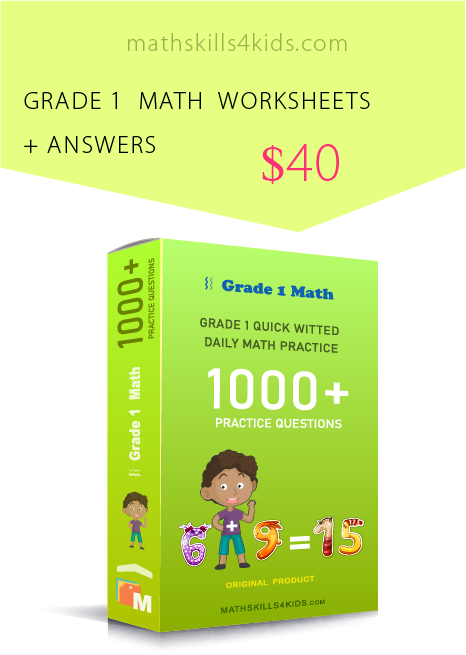
Buy Now...
-
-
How do you make units of measurement fun and engaging for your kids?
Here are some suggestions:
- Start with familiar objects and situations. For example, you can ask your kids to measure their height, weight, shoe size, arm span, etc. You can also use everyday items such as books, pencils, cups, spoons, etc., to measure length, mass, volume, etc.
- Use different tools and methods to measure the same thing. For example, you can use a ruler, a tape measure, a yardstick, or your hand to measure length. You can measure mass using a scale, balance, or estimation.
You can also use a measuring cup, a graduated cylinder, or your estimation to measure volume. You can use a thermometer, a weather app, or your estimation to measure temperature.
- Compare and contrast different units of measurement. For example, you can ask your kids to compare inches and centimeters, pounds and kilograms, cups and liters, degrees Fahrenheit and degrees Celsius, etc. You can also ask them to convert between different units of measurement using formulas or tables.
- Relate units of measurement to real-world situations. For example, you can ask your kids to estimate how much water they drink daily in cups or liters. You can also ask them to calculate how much money they need to buy a certain amount of candy in pounds or kilograms.
-
How to teach your kids the basics of length, mass, and volume
One of the most important skills that 3rd graders need to learn is how to measure different things using units of measurement. Units of measurement are standard ways of describing how long, how heavy, or how much space something takes up.
For example, we can use inches, feet, yards, and miles to measure length and distance. We can use ounces, pounds, tons, and grams to measure weight and mass. We can measure volume and capacity using cups, pints, quarts, gallons, liters, and milliliters.
But how do you teach your kids the basics of length, mass, and volume in a fun and engaging way? Here are some tips and ideas to help you out:
- Start with familiar objects and situations. Use things your kids see and use daily, such as toys, books, food, clothes, etc. Ask them questions like: How long is your pencil? How heavy is your backpack? How much water can you fit in this bottle? Please encourage them to use different units of measurement to describe the same thing.
For example, your pencil is 7 inches long or 18 centimeters long. Your backpack is 5 pounds heavy or 2 kilograms heavy. Your bottle can hold 16 ounces of water or 500 milliliters of water.
- Use hands-on activities and experiments. Kids learn best by doing, so let them explore and discover the concepts of length, mass, and volume by themselves. You can use simple materials and tools at home or in the classroom, such as rulers, scales, measuring cups, spoons, etc.
You can also use online simulations and games that let them practice measuring different things virtually. Some examples of activities and experiments are:
- Measuring the length of different body parts using a tape measure or a string.
- Comparing the weight of different objects using a balance or bathroom scale.
- Finding out how much liquid different containers can hold using measuring cups or bottles.
- Make connections and comparisons. Help your kids understand the relationships between different units of measurement and how to convert from one unit to another. For example:
- There are 12 inches in a foot and 3 feet in a yard.
- There are 16 ounces in a pound and 2,000 pounds in a ton.
- There are 8 ounces in a cup and 4 cups in a quart.
You can also use visual aids like charts, tables, diagrams, etc., to show these connections and comparisons. You can also use real-life examples, such as recipes, maps, sports scores, etc., to show how units of measurement are used in different contexts.
- Review and reinforce. After teaching your kids the basics of length, mass, and volume, it is important to review and reinforce what they have learned. You can use worksheets, quizzes, tests, etc., to check their understanding and progress. You can also use games, puzzles, riddles, etc., to make the review process more fun and challenging.
- Start with familiar objects and situations. Use things your kids see and use daily, such as toys, books, food, clothes, etc. Ask them questions like: How long is your pencil? How heavy is your backpack? How much water can you fit in this bottle? Please encourage them to use different units of measurement to describe the same thing.
-
Free printable worksheets for 3rd graders: Practice and review units of measurements
One of the best ways to practice and review units of measurement is by using worksheets. Worksheets are great because they let you practice different skills at your own pace and level. They also let you see your mistakes and correct them.
That's why we have selected the best free printable worksheets for 3rd graders on units of measurement from Mathskills4kids.com. These worksheets cover some of the most important skills that 3rd graders need to master when measuring length, mass, and volume.
Some examples of skills covered in these worksheets are:
- How to read a thermometer: This worksheet teaches kids how to read a thermometer and measure temperature using degrees Fahrenheit and Celsius.
- How to measure using an inch ruler: This worksheet teaches 3rd graders how to measure using an inch ruler and how to estimate length using inches.
- Measuring length and distance: This worksheet teaches Grade 3 students how to measure length and distance using different units of measurement such as feet, yards, meters, etc.
- Measuring weight and mass: This worksheet teaches children how to measure weight and mass using different units of measurement such as ounces, pounds, grams, etc.
- Measuring volume and capacity: This worksheet teaches kids how to measure volume and capacity using different units of measurement such as cups, pints, quarts, liters, etc.
- Comparing and converting units of measurement: This worksheet teaches children how to compare and convert units of measurement using different strategies such as multiplying, dividing, using fractions, etc.
- Customary units conversion tables: Complete the missing cells: This worksheet teaches students how to use customary units conversion tables to convert from one unit of measurement to another. You have to fill in the missing cells in the tables using the given information.
- Choosing the correct measuring tool: This worksheet teaches 3rd graders how to choose the correct measuring tool for different situations. You have to match the measuring tool with the object or quantity that needs to be measured.
- Measurement word problems: This worksheet teaches kids how to solve word problems involving units of measurement. You have to read the problem carefully and use the appropriate operation and unit of measurement to find the answer.
You can download these worksheets for free by clicking on the links below. You can print or use them on your computer or tablet with your kids. You can also check your children’s answers using the answer keys provided.
-
Fun activities and games to reinforce units of measurement skills
Besides worksheets, another way to practice and reinforce units of measurement skills in 3rd graders is by doing fun activities and games. Activities and games are great because they let children learn by doing and having fun. They also let children work with other classmates and friends and share ideas.
That's why we have collected some of the best activities and games that you can do at home or in the classroom with your 3rd graders to uplift their units of measurement skills.
These activities and games cover some of the most important concepts and skills that 3rd graders need to learn when measuring length, mass, and volume.
Some examples of activities and games are:
- Make your ruler: This activity lets children make their ruler using a piece of paper, a pencil, and scissors. They can use their ruler to measure different things around them.
- Estimate and measure: This activity lets 3rd graders estimate and measure different things using different units of measurement. They can use a ruler, a tape measure, a scale, a measuring cup, etc. They can also compare your estimates with their actual measurements.
- Unit Bingo: This game lets students practice identifying different units of measurement for length, mass, volume, They can use a bingo card with different units of measurement on it. They can also use a spinner or a dice to call out the units.
- Unit conversion race: This game lets your Grade 3 students practice converting from one unit of measurement to another. They can use cards with different conversion problems on them. They can also use a timer or a stopwatch to see who can solve the most problems quickly.
- Measurement scavenger hunt: This game lets children find different things that match certain criteria involving units of measurement. They can use a list of clues or questions that ask them to find things that are a certain length, weight, volume, etc. They can also use a camera or a phone to take pictures of their findings.
-
How to assess your kids' progress and mastery of units of measurement
One of the most important aspects of teaching units of measurement is to check how well your kids have learned the concepts and skills. There are different ways to assess your kids' progress and mastery of units of measurement, such as:
- Using the free printable worksheets for 3rd graders as quizzes or tests. You can grade them based on accuracy, completeness, and neatness. You can also give feedback and corrections to help your kids improve their understanding and performance.
- Ask your kids to explain how they solved a measurement problem or why they chose a certain unit or tool. This will help you gauge their reasoning and communication skills, as well as their confidence and interest in units of measurement.
- Observing your kids as they do the fun activities and games that reinforce units of measurement skills. You can look for engagement, enjoyment, curiosity, and creativity signs. You can also ask them to share what they learned or discovered from the activities and games.
- Using online resources that provide interactive quizzes, games, and simulations that test your kids' knowledge and skills in units of measurement. Some of these resources also give instant feedback and scores that you can use to track your kids' progress and achievements.
The best online resources for learning units of measurement
If you are looking for more ways to help your kids learn units of measurement, you can explore some of the best online resources that offer an engaging unit of measurement content.
Here are some examples of online resources that you can use:
- Math Playground: This website has a variety of math games that cover topics such as measurement, geometry, fractions, decimals, and more. Using different units and tools, you can find games that teach your kids to measure length, weight, volume, temperature, time, and angles.
Some of the games are: Measure It!, Measuring Angles with a Protractor, Measuring Volume with Unit Cubes, Measuring Temperature with Thermometers, etc. You can access these games at https://www.mathplayground.com/measurement_games.html.
- Khan Academy: This website has a comprehensive collection of videos, articles, exercises, and quizzes that cover various math topics for different grade levels. You can find lessons that teach your kids the basics of units of measurement, such as what they are, why they are important, how to convert between them, how to choose the appropriate unit and tool for a given situation, etc.
Some lessons are; Introduction to Measurement, Converting Units of Length, Converting Units of Mass and Volume, Customary Units of Measurement Review, Metric Units of Measurement Review, etc. You can access these lessons at https://www.khanacademy.org/kmap/measurement-and-data-e/map-units-of-measurement.
- BrainPOP: This website has animated videos that explain various math concepts in a fun and easy way. You can find videos that introduce your kids to units of measurement, such as what they are, how they are used in everyday life, how they are related to each other, etc.
Measurement Basics (https://www.brainpop.com/math/geometryandmeasurement/measurementbasics/)
-
Thank you for sharing the links of MathSkills4Kids.com with your loved ones. Your choice is greatly appreciated.
Conclusion: Keep Practicing and Have Fun
Units of measurement are essential for understanding the world around us and solving problems in math and science.
By using Mathskills4kids’ free printable worksheets for 3rd graders, the fun activities and games, and other online resources we have shared with you in this article, you can help your kids learn units of measurement in a fun and effective way.
We hope you enjoyed this article and found it useful for teaching your kids units of measurement.
Happy measuring!
